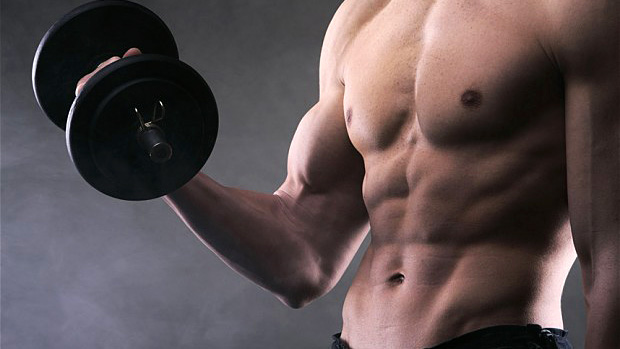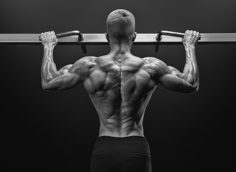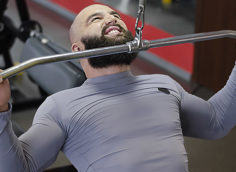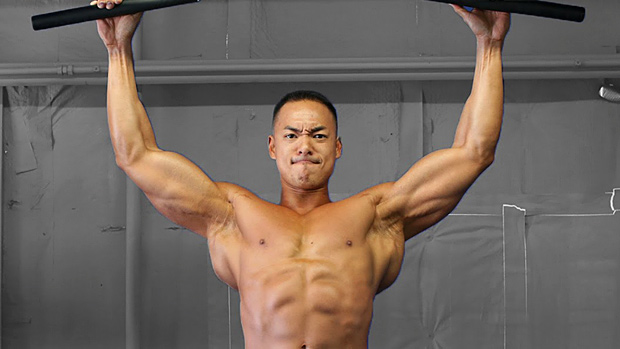Bodybuilding coaches are all bastards.
They all make me sick.
It's true.
Alright, I don't really feel that way, but I sometimes wish they could all agree on something when it comes to lifting weights.
I commiserate with the average reader who wants to latch his cart onto some philosophy that'll help him navigate the torturous route to buffdom, but who gets so confused by all the differing opinions that he opts to take up ballroom dancing instead.
In an effort to find at least a little bit of consensus regarding one topic, biceps training, I contacted four of T Nation's coaches:
Alwyn Cosgrove
Erik Minor
Chad Waterbury
Dr. Clay Hyght
Like a hockey referee during face-off, I dropped 3 different "pucks" onto the ice for them to slap around. Each consisted of one of the various "truisms" concerning biceps training that we've all read here on T Nation.
Let's hope there's at least a little consensus.
TC: Let's kick this off by discussing one of the most depressing "truisms" regarding biceps development: You need to gain about 15 pounds of muscle before your arms will get appreciably larger.
Alwyn Cosgrove: Well, the easiest way to get bigger arms is to get YOU bigger, so big bang exercises like deads, squats, etc. are actually powerful tools.
However, it's not the right answer to the question as what you REALLY mean, is how do I get bigger arms IN RELATION TO everything else? That's a different strategy and requires either direct arm training, or finding out the "weak link" and why they won't grow.
Now that's a good topic for discussion.
Erik Minor: At my biggest, my arm measurement topped out at 19 inches, flexed. This was at a bodyweight of 207 lbs. My current arm measures 17.75 inches flexed at a bodyweight of 194.
Bodyweight gain is a side effect of muscle hypertrophy. So yes, you will need to gain mass to increase arm size. But specific gains in weight correlating to specific increases in arm circumference is just guesswork.
It's simple; your biceps will not grow unless you train them to handle more stress and do more work. This may sound a bit arrogant, but I have never met anyone of equal bodyweight that had arms as big as mine and who did not perform direct arm work.
Train your damn arms!
Chad Waterbury: You really do need to gain muscular body weight in order to make your arms bigger. It's tough to qualify, but the relationship between 15 pounds of new muscle for an extra inch of upper arm girth probably isn't far off.
From my experience, the fastest gains in muscular body weight come from three full body workouts each week, like I laid out in my book, Huge in a Hurry. That's why I preach the full body gospel when people want bigger arms, or a bigger, more muscular body, in general.
However, I remember years back when a former T Nation writer was asked about the necessity of adding 15 pounds of muscle in order to gain an inch on your arms. His reply: "Tell that to a paraplegic."
It was a great answer. Yes, most paraplegics – especially those who compete in sporting events – have incredible upper arm development, despite their loss of body weight. However, it's simply not realistic to prescribe that much training volume to the average musclehead.
Clay Hyght: My question is... who in the hell can't get their arms to grow after gaining 15 pounds of mass?! That's simple!
But as a coach of some high-level physique competitors, I'd better be able to get someone's arms to grow without gaining a ton of mass. Otherwise I'll soon be asking, "Would you like fries with that?"
Sure, it's a lot easier to get your arms to grow if you're packing on the pounds, but it's certainly not necessary. In fact, I've had numerous people gain size on their arms while actually dropping body fat. It's definitely a challenge, but it can be done.
TC: Okay, there was some consensus there, but obviously not everyone is on the same page. It seems that weight gain is definitely helpful (duh!), but all agree, in varying degrees, that you can add size to the biceps without adding a lot of weight to your body.
Let's get to truism number 2: I should be able to do 15 one-arm chin-ups, or something along those lines, before I even think about doing direct biceps work.
Okay, I'm exaggerating about the one-arm chin-ups, but I'm always hearing about how I need to be able to do a certain number of chin-ups before I start doing direct biceps work.
AC: For most beginners and intermediates, direct arm work is unnecessary as the biceps get enough stimuli from rowing and chins. Simply put, if you can't do a couple of sets of 10 full range chins and dips, there is no real benefit to direct arm training.
But at some point, like intermediate to advanced lifters training for aesthetics, they could benefit from some direct work.
But we coaches have definitely overreacted there. Adding a couple of sets of direct arm training is a good idea. Just make it an angle that is different from rows and chins ... and don't stop doing them either! So for biceps, maybe incline DB curls would be a better choice than standing barbell curls when you look at a different exercise.
EM: Personally, I think chin-ups are a poor choice for biceps development. The ability to perform chin-ups is a task based on the strength of the shoulder flexors, elbow flexors, core strength, and grip strength.
Tell me, which muscle is limiting your pull-up ability? Go to the chin-up bar, do as many reps as possible. Which area fatigues first? You just found your weak link for the chin-up. If the weak link is the shoulder extensors, you'll never fully develop your biceps with chin-ups. If your biceps are the weak link, then your lats won't get thorough stimulation. Get my point?
The weakest link is always the limiting factor for compound exercise.
CW: If you can do 15 one-arm chin-ups, your biceps are as big as your body is capable making them. I think it's an excellent goal to shoot for, but it's probably not realistic for guys who weigh over 200 pounds.
For intermediate and advanced lifters, there's value in adding direct biceps work to a program that already consists of three full body workouts each week. To gain muscle, you need more volume. For many lifters, 5 sets of 5 reps for the hammer curl or reverse curl or dumbbell curl, after each full body workout, will give them more biceps mass.
CH: Well, I guess I've wasted 20 years of direct arm training, because I can't do 15 one-arm chin-ups. Nonetheless I have some pretty decent arms, if I may say so myself!
That being said, using an arbitrary measure of strength as an indicator of when direct arm training is applicable is silly.
Of course, someone who can't deadlift 400 pounds or so probably shouldn't be too concerned with doing concentration curls. Most beginners would be better off focusing on building a good solid base prior to worrying about bigger arms or a bigger upper chest.
If your arms are under 15 inches and you're doing concentration curls and cable curls, then your arms will probably stay under 15 inches.
TC: Okay, it seems that the consensus is that you're better off being strong overall before you bother spending your time doing concentration curls. However, Erik definitely doesn't think that chin-ups are much of a biceps movement. Fair enough.
Let's go to the third truism, which is what a few of you have already alluded to: All I need to do are total body workouts consisting of Bulgarian one-legged power cleans and my biceps will magically grow.
Again, I'm being snarky. What I meant to say was that all you need to do for your biceps to grow are total body workouts. How true is that?
AC: Total body workouts will make everything grow, if they are TOTAL body indeed and not an excuse to miss certain movements or muscles. The key principle for hypertrophy is overload, through frequency, intensity, and volume. If this is violated, you won't grow, period, no matter what split you are on.
A split routine just reassigns the training volume for the muscle group for that week and puts it on, for example, one day. A total body routine takes that same volume and divides it over multiple days. Total volume and intensity should be the same per training week or we're comparing apples to oranges.
A study by McLester, et al, compared the same volume divided over 3 workouts as opposed to one workout, i.e. 3 sets per day, three times per week, versus nine sets once per week, and found that the one day per week group only achieved 62% of the strength improvements of the 3 day group and a lesser increase in muscle.
And another paper by Wernbom, et al, concluded that 2-3 times a week per muscle group seemed optimal for hypertrophy
Looking at both of those studies, I think you need to train biceps at least twice a week; I think the once per week split is too little frequency for most.
EM: Let me say this loud and clear: compound exercises – squats, presses, and chin-ups – are the least effective tool for addressing weak links!
I can improve a trainee's chin-up ability by addressing weakness in the elbow flexors alone because the nervous system will shift more stress to the stronger muscles.
Nothing happens in a straight line; you don't lose fat in a straight line, you don't gain strength in a straight line, and your muscles don't grow uniformly. Everything occurs in a wiggly line, which means you must constantly correct imbalances that naturally occur with training!
CW: A beginner can add plenty of upper arm mass with a full body circuit such as the chin-up/dip/deadlift. Any heavy pulling movement with a palms up grip will help your biceps, provided the total volume is sufficient, i.e. over 24 total reps. Remember, one of Dorian Yates favorite biceps exercises was the Yates Row: a heavy barbell row with a palms up grip.
Your first two inches of upper arm growth, from baseline, will come fastest from chin-ups, dips, close grip bench presses, and palms-up rows. From there, direct arm work for the forearms, biceps, and triceps will typically expedite the next phase of growth.
CH: The fact of the matter is, a total body training routine that does not have much, if any, direct arm work is simply not going to elicit huge arms!
Sure, there are some obscure studies somewhere that show that people's arms grew even though they didn't train them directly... yada yada yada.
Yes, if you are a beginner or maybe even an intermediate with limited time to go to the gym, then doing direct arm work is not going to give you the most bang for your buck.
However, assuming you are a fairly experienced lifter with a decent base, then to get bigger arms you're going to have to... guess what... train your arms!
If you want to learn to speak Spanish, do you study German? Enough said.
AC: Did Clay just "yada yada" me because I quoted some "obscure" studies?
TC: You bet your Scottish ass he did.
Anyhow, at last, some consensus! All of you agree that some direct biceps work is necessary, although Chad believes that approximately the first two inches of upper arms growth would come most easily from total body work.
But, as is often the case, you've all corn-fused the hell out of everybody. What is the reality of training biceps? Which of the above "rules" is true, and to what degree? In other words, what the hell should I do?
AC: TC, did you just confess to having a biceps day? Today is sternocleidomastoid and cremaster day for me...
TC: It's a hypothetical question, you douche. I'm acting as a journalist.
AC: Alright, alright.
Train the entire body at least twice every seven-day period.
Train with primarily compound exercises and work hard on increasing SOMETHING (reps, load, reducing rest period etc) every workout. For biceps that means chins, and rows.
Throw in some isolation work as necessary but keep the volume low in comparison to the compound lifts. Effectiveness first (good exercises); intensity second; frequency third; volume last.
Don't try to make up for a lack of intensity by doing more sets.
Divide your "split" up however you wish without breaking the above rules.
It's kind of like my article about "releasing the brakes" article: If your arms aren't growing....
- Are you training heavy? Doing the ugly stuff? Deadlifts, chins, rows, etc. with good form and smart progressions?
- Eating well and recovering?
- Are you doing some direct overload for that muscle group directly?
- Is there a weak link elsewhere holding you back?
We'd just go down the list.
If you aren't doing chins, etc, overloading the body and eating well – then no amount of cable curls will help you. But if that's in place - then additional direct overload is the next key.
EM: Hypertrophy is specific to the stress placed upon the muscles involved. The sporting world gives distinct clues to muscle adaptation and specificity. For example: velodrome cyclists have huge legs and small upper bodies; sprinters have well developed hamstrings and glutes but relatively small quadriceps. This indicates that even gross sports movements create specific muscle hypertrophy.
I have always been an advocate of weak link training because it works. My clients don't give a shit what training protocol is in style, they just want to look better, perform better, and/or feel better.
CH: Getting big biceps is not rocket science. However, there are some tips and tricks that can help you along the way.
As is the case with training in general, and the most common mistake that I see with arm training is that people use pansy ass movements and weight that is far too light. Why in the world someone would do high pulley cable curls as opposed to barbell curls is beyond me.
Wait, never mind, I do know why they choose that... because it's easy and you can see your pretty biceps working in the mirror.
That's fine and dandy but you're not going to get big arms like that!
If you want to get big, after making your excuses, get off the fancy machines and do some barbell curls, alternating dumbbell curls, and preacher curls for biceps along with skull crusher's, close grip bench press, and overhead dumbbell extensions.
Although most people are not able to improve their arms because they're simply avoiding hard work, there is a certain group of people that overtrain their arms. You have to keep in mind that you're using your biceps when training back and you're especially using your triceps when you train chest and shoulders.
For that reason, the overall volume of your arm workouts should typically be a bit lower than that of other body parts.
However, one of my most common methods for helping someone bring up their arms almost goes contrary to that point.
Practically everyone gets great results by doing 3 brief arm workouts per week, while still just training each other body part once per week. Each of these brief arm routines should have one exercise for biceps and one for triceps. After doing this for 6 to 8 weeks, take a full week off from arm training, and then resume a more standard arm workout.
I will leave you with this tip: use a variety of set and rep schemes, 5 sets of 5 is fantastic for enhancing strength, and even some size.
On the other hand 3 sets of 8 to 12 reps is practically perfect for size and strength. Yet doing 3 sets of 15 to 20 reps with a short rest in between works incredibly well at enhancing size by stimulating nonfunctional hypertrophy.
So which method is best? None. They are all good!
Now, enough with the stupid roundtable – let's get to the pose down!
Chad "Hollywood" Waterbury: Chad was unavailable for final comment as he had to hurry to Wolfgang Puck's in Malibu to meet with Heidi and Spencer, aka "Speidi." And I'm not kidding.
So to paraphrase Craig Ferguson's cute little kitty at the end of each show, what did we learn on the site today, TC?
We learned that adding size to the biceps doesn't necessarily require that you gain tons of body weight.
We learned that 2 out of our 4 bodybuilding coaches think that chins are an excellent biceps exercise that can go a long way in developing the size of the biceps. The other 2 bodybuilding coaches spit on that notion.
We learned that doing total body workouts will help build the size of the biceps, but most bodybuilding coaches still believe that direct biceps work is crucial.
Most importantly, we learned that just about everything works, as long as it's applied with logic, progression, passion, and intensity.





